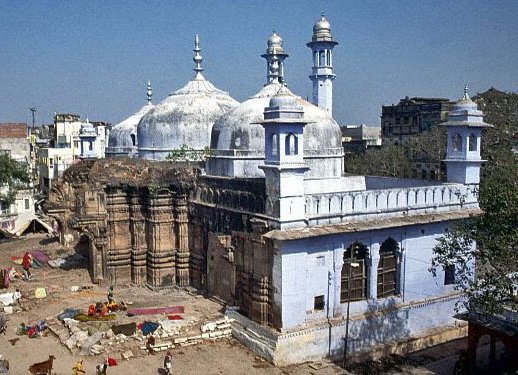Suit For Restoration Of Ancient Hindu Temple At Gyanvapi Mosque: Mosque Management To File Reply

A civil Court at Varanasi took up for hearing today, seeking removal of the Gyanvapi Mosque in Mathura and for the restoration of Temple rituals. The Mosque Management appeared in Court today and sought time to file a reply.
Filed on behalf of Advocate Vishnu Shankar Jain, the plea by the devotees and worshippers as next friend of the plaintiff deities in the Court of Senior Division Judge, Varanasi contends that “Asthan Lord Adi Visheshwar, Jyotirlinga” was damaged in 1669 under the orders of Mughal Ruler Aurangzeb but “Maa Shringar Gauri, Lord Ganesh and other subsidiary deities” continued to exist within the ancient temple, which is claimed by Muslims to be part of the “Gyanvapi Mosque”.
The instant suit is filed for restoration of Darshan and performance of rituals at the principle seat of Asthan of Lord Adi Visheshwar and of Goddess Maa Shringar Gauri, the Ardhangni and devotee of Lord Adi Visheshwar along with Lord Ganesh, Nandiji and other deities within the precincts of temple complex known as “Ancient Temple” existing at Settlement Plot No.9130.
Challenging Section 4 of the Places of Worship (Special Provisions) Act, 1991, the petition says, “Parliament has no power to make any law which takes away or abridges the rights conferred by Article 25 of the Constitution of India. Section 4 of the Act infringes the right to religion of Hindus as their right to remedy to approach the court has been taken away by Places of Worship Act, 1991 and therefore, Section 4 (four) of the Act is ultra vires and void.”
“A sovereign republic governed by rule of law is not supposed to bent before a religious community due to fear or favour and such an action is disastrous for the governance of the country affecting the sentiments of present and future generation leading to haunt the mind of the subjects of the country to understand that still we are slaves of those who had trampled our culture and we are helpless to restore our cultural heritage.”, the plea states.
Prayer has been sought to;
(1) Declare the Right of worshippers and devotees to have Darshan, Pooja and Worship of deities within the area in question.
(2) Declare the entire Avimukteshwar area within the radius of “5 Kos” of principal seat, in name of plaintiff deity Asthan Lord Adi Visheshwar.
(3) Grant Perpetual injunction against the defendants prohibiting them from interfering with, or raising any objection in the construction of New Temple building consisting of Goddess Maa Shringar Gauri along with Lord Ganesh, Nandi Ji and other subsidiary deities at Principal seat of Asthan Adi Visheshwar after demolishing and removing the existing buildings and structures situated there at.
(4) Grant Mandatory Injunction directing defendant No. 2 (Govt. of UP) and Defendant No. 7 (Board of Trustees of Kashi Vishwanath Temple) to restore pooja and worship of “Goddess Gauri Shringarji, Goddess Maa Ganga, Lord Hanuman, Lord Ganeshji, Nandiji” alongwith “Lord Adi Visheshwar” and make appropriate arrangement for Darshan by worshippers, to maintain law and order situation.
Plaintiffs in the suit are;
(1) Maa Shringar Gauri revealed near Adi Visheshwar Shivlingam, being worshiped from time immemorial within the ancient temple, filling through next friend and devotee Ms. Ranjana Agnihotri.
(2) Asthan Lord Adi Visheshwar, Jyotirlinga represented by next friend and devotee Jitender Singh
All other Plaintiffs are devotees of Lord Adi Visheshwar and Goddess Maa Shringar Gauri asserting their right to worship, Darshan, Pooja and for performing other rituals at the principal seat of deity Lord Adi Visheshwar in the ancient temple complex.
The petition places on record the history of Kashi and the attack by Mughal emperor Aurangzeb; “That on 18.04.1669 Aurangzeb had issued farmaan for demolishing the temple of Lord Shiva, that is, Adi Visheshwar at Benaras.” Reliance in this regard is placed on Historian Sir H.M. Elliot and John Dowson’s book ‘The History of India’.
The importance of the Adi Visheshwar Jyotirling at Kashi has been reproduced citing extracts from Shree Skand Puran and Shiva Mahapuran. Reference is also drawn to the Supreme Court finding in Shri Adi Vishehwar of Kashi Vishwanath v. State of UP, (1997) 4 SCC 606;
“According to Puranic Mahatmya and Kashi Khanda of the Skanda Purana, the Jyotirlinga was established by Lord Shiva himself when he went into exile to the Mount Mandara during the reign of the legendary King Divodasa. Since Lord Shiva himself disguised the Linga, according to Mahatmya Lord Shiva never really left the sacrosanct and sacred temple. Hence, it became “Avimukta” (Never Forsaken). This was also stated by Vaachaspati Mishra in his famous Puranic work “Tirtha Chintamani” in 1460 (Fourteen Sixty) wherein he had stated that “Visheshwara” and “Avimukteshwara” were merely two names for the same Jyotirlinga. Narayan Bhatta had similarly mentioned it to be so in 16th (Sixteenth) century in his work “Tirthalisetu”.”
The petitioner precisely avers that the present suit seeking declaration and perpetual injunction against the defendants, so to perform religious prayers and practice falls within the ambit of Article 25, Constitution of India. The devotee plaintiffs are worshipper of Lord Shiva and they practice, profess and propagate Vedic Sanatan Hindu Dharma and are competent to bring this suit in the interest of deities and for the benefit of other devotees.
Case Title: Goddess Maa Shringar Gauri through next friend and devotee Ranjana Agnihotri & Ors. v. Union of India & Ors.
